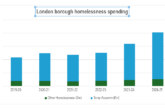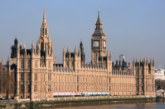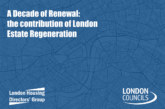London boroughs have unveiled a list of key infrastructure projects needed to secure “a more prosperous, inclusive, and sustainable” future for the capital.
For the first time, all 33 of the capital’s local authorities have agreed an infrastructure framework on a cross-party, pan-London basis, with the aim of using infrastructure investment to boost prosperity, reduce inequalities, and help achieve net zero across the capital. The framework was officially launched at UKREiiF 2023 in Leeds yesterday (17th May).
Launched by the umbrella group London Councils, the London infrastructure framework identifies major development opportunities for stimulating economic growth — ranging from extending the Bakerloo line through to a sewage-powered domestic heating scheme.
Alongside the launch of the framework highlighting opportunities for growth, London Councils emphasised the capital’s immense social and economic challenges. London currently has the highest unemployment in the UK [1] and its productivity growth has stagnated [2], while boroughs are also determined to strengthen the capital’s climate resilience and make faster progress towards decarbonisation.
The framework, which has been developed with the boroughs by the economic consultancy Metro Dynamics and through close working with the Greater London Authority and Transport for London, will help address these challenges by promoting more efficient planning and delivery of infrastructure and enabling a more united pan-London voice to support projects in accessing funding.
With boroughs acknowledging the opportunities require significant funding from central government or private investment partners such as pension funds, London Councils is also calling for a new devolution deal to support the infrastructure ambitions.
Boroughs argue further devolution incorporating gainshare principles would enable them to retain and invest more of the proceeds of locally driven growth in the capital in return for London generating a higher rate of growth for the UK.
In total, 67 projects are included in the infrastructure framework based on boroughs’ strategic priorities and the classification used by the National Infrastructure Commission [3]. The priorities focus on embedding inclusive and sustainable growth, and example projects include:
- Connected London, which is currently delivering 2,000km of full fibre connectivity across the London Underground, bringing city-wide connectivity improvement and readying London for 5G.
- Waterloo City Hub. A redesign of the roundabout, roads, and surrounding public realm at Waterloo will unlock and support growth as well as improve local connectivity, particularly towards the South Bank.
- Bakerloo line extension to south-east London. The proposed extension of the Bakerloo line would support the development of over 110,000 new homes and 130,000 jobs across the capital.
- Elizabeth line continuation to Kent. Extending the new line beyond Abbey Wood and into Kent.
- Sewage-powered domestic heating scheme in Kingston. Excess heat recovered from the sewage treatment process could be used to power more than 2,000 homes thanks to a new carbon-cutting partnership between Kingston Council and Thames Water.
Cllr Elizabeth Campbell, London Councils’ Executive Member for London’s Future: Business, Economy and Culture, said: “Boroughs are collaborating like never before to promote infrastructure investment in the capital and help us achieve our shared vision of a more prosperous, inclusive and sustainable London.
“By setting out boroughs’ agreed priorities and the exciting range of development opportunities across the capital, the London infrastructure framework will drive investment towards where it will make the most difference.
“But alongside this new framework, we are also calling for a new devolution deal for the capital to support boroughs’ ambitions around growth and infrastructure. Letting boroughs keep more proceeds from locally driven growth would help us secure investment for these strategic projects and bring benefits not only to Londoners but the UK economy as a whole.
“London undoubtedly faces immense challenges and we cannot afford to be complacent about its future. Boroughs are more determined than ever to work with each other and with our partners in City Hall and central government, as well as with private investors. Together we can secure the infrastructure London needs to thrive in the coming years and maximise its contribution to the UK’s economic well-being.”
More information on the London infrastructure framework can be found on the London Councils here.
[1] London currently has the highest unemployment rate (4.7%) of any region in the UK. Source: the ONS.
[2] In March 2023 the Centre for Cities think-tank published a report showing that London’s average annual productivity growth was just 0.2% between 2007 and 2019 — a drop of 2.9 percentage points compared to the previous decade. The report warns that stagnation in London “has been the main cause of the UK’s productivity struggles, costing the national economy tens of billions of pounds per year”.
[3] Aligning with the National Infrastructure Commission’s classification, the London infrastructure framework includes projects relating to transport, energy, waste and wastewater, flood risk management, digital communications, and waste. While housing and social infrastructure are not included in the framework, London’s priorities also take into account the infrastructure schemes that can unlock wider development.
Header image ©Jamo Images/AdobeStock










